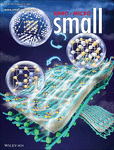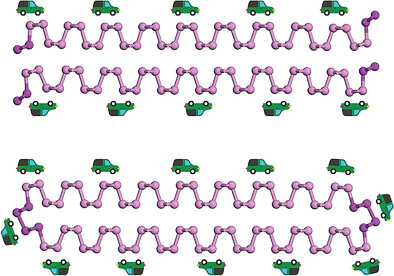Journal list menu
Export Citations
Download PDFs
Cover Picture
Lithium Storage Mechanism and Application of Micron-Sized Lattice-Reversible Binary Intermetallic Compounds as High-Performance Flexible Lithium-Ion Battery Anodes (Small 2/2022)
- First Published: 13 January 2022
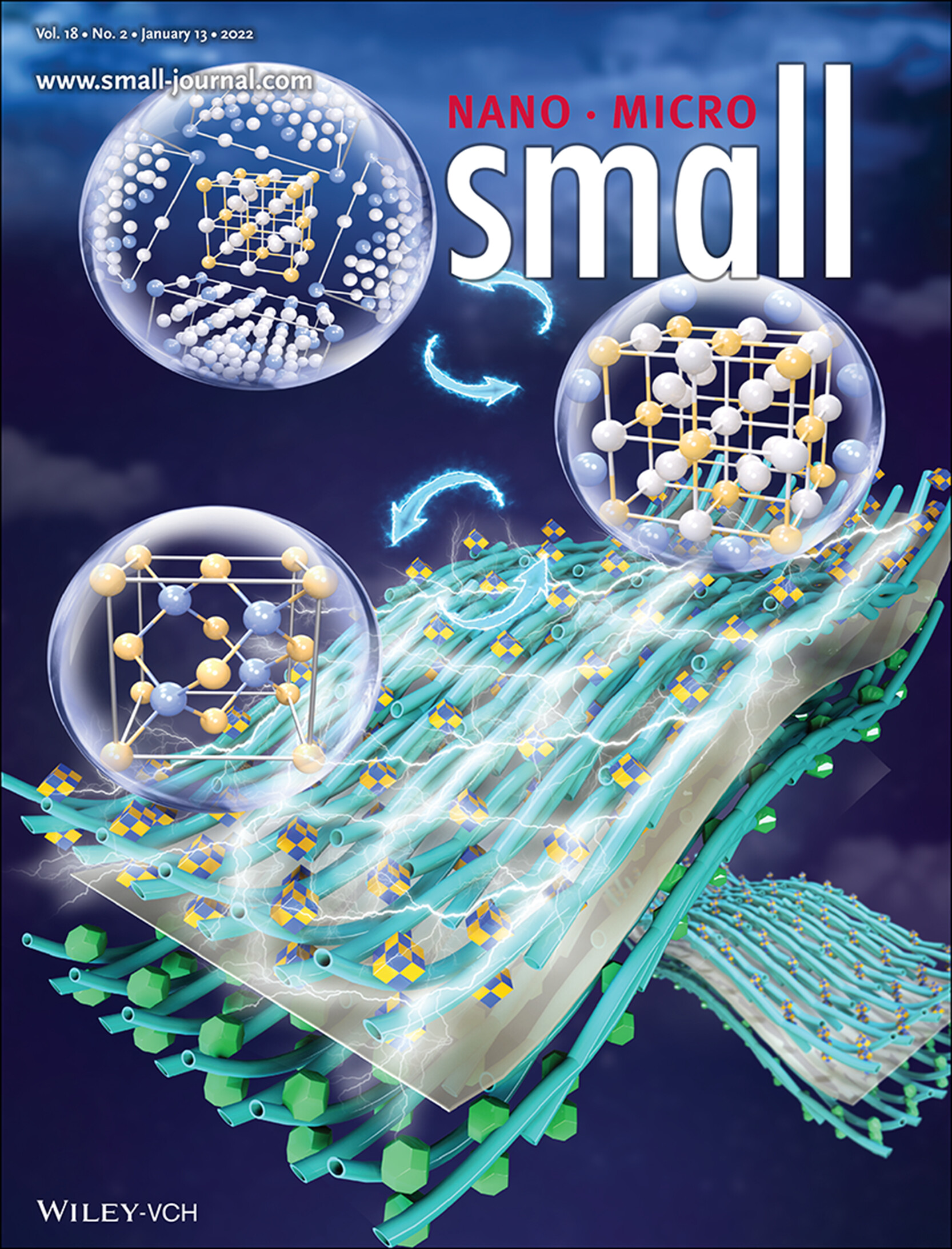
Lithium–Ion Batteries
In article number 2105172, Jiaping Wang and co-workers propose lattice-reversible binary intermetallic compounds with zinc blende structure as a promising anode material for high-performance flexible lithium–ion batteries. The micron-sized indium antimonide/carbon nanotube electrodes with low volume expansion demonstrate outstanding cycle stability, rate performance, and flexibility.
Inside Front Cover
Electronic Structure Regulation of Iron Phthalocyanine Induced by Anchoring on Heteroatom-Doping Carbon Sphere for Efficient Oxygen Reduction Reaction and Al–Air Battery (Small 2/2022)
- First Published: 13 January 2022
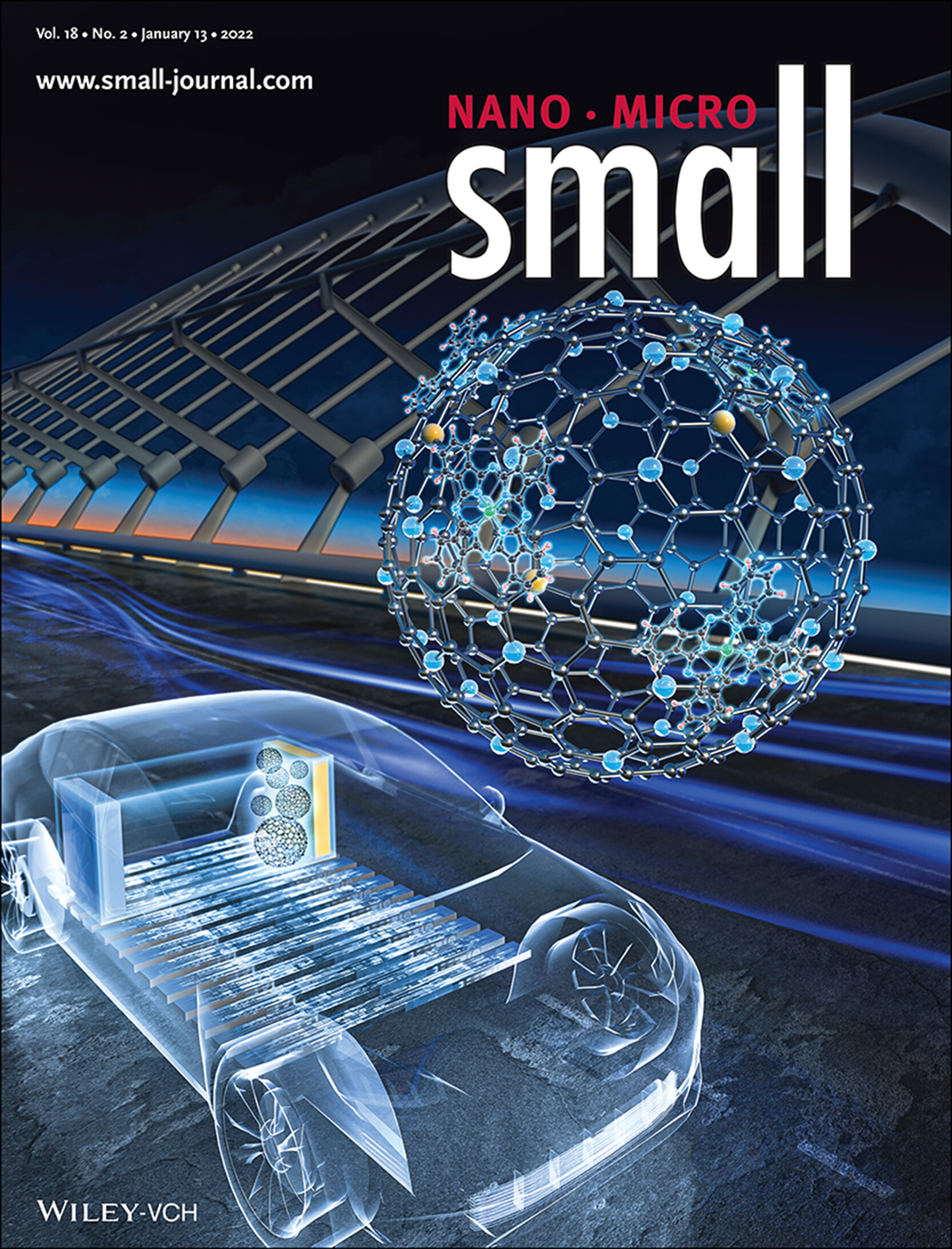
Metal–Air Batteries
In article number 2105594, Miao Yu, Jie Zhang, and co-workers report the development of iron phthalocyanine (FePc) anchored onto N,S–doped hollow carbon spheres (HNSCs) to form FePc@HNSC. The charge distribution and d–band center of Fe atoms can be efficiently optimized. The material is applied as an efficient oxygen reduction electrocatalyst for aluminum–air batteries.
Inside Back Cover
Directionally In Situ Self-Assembled, High-Density, Macropore-Oriented, CoP-Impregnated, 3D Hierarchical Porous Carbon Sheet Nanostructure for Superior Electrocatalysis in the Hydrogen Evolution Reaction (Small 2/2022)
- First Published: 13 January 2022
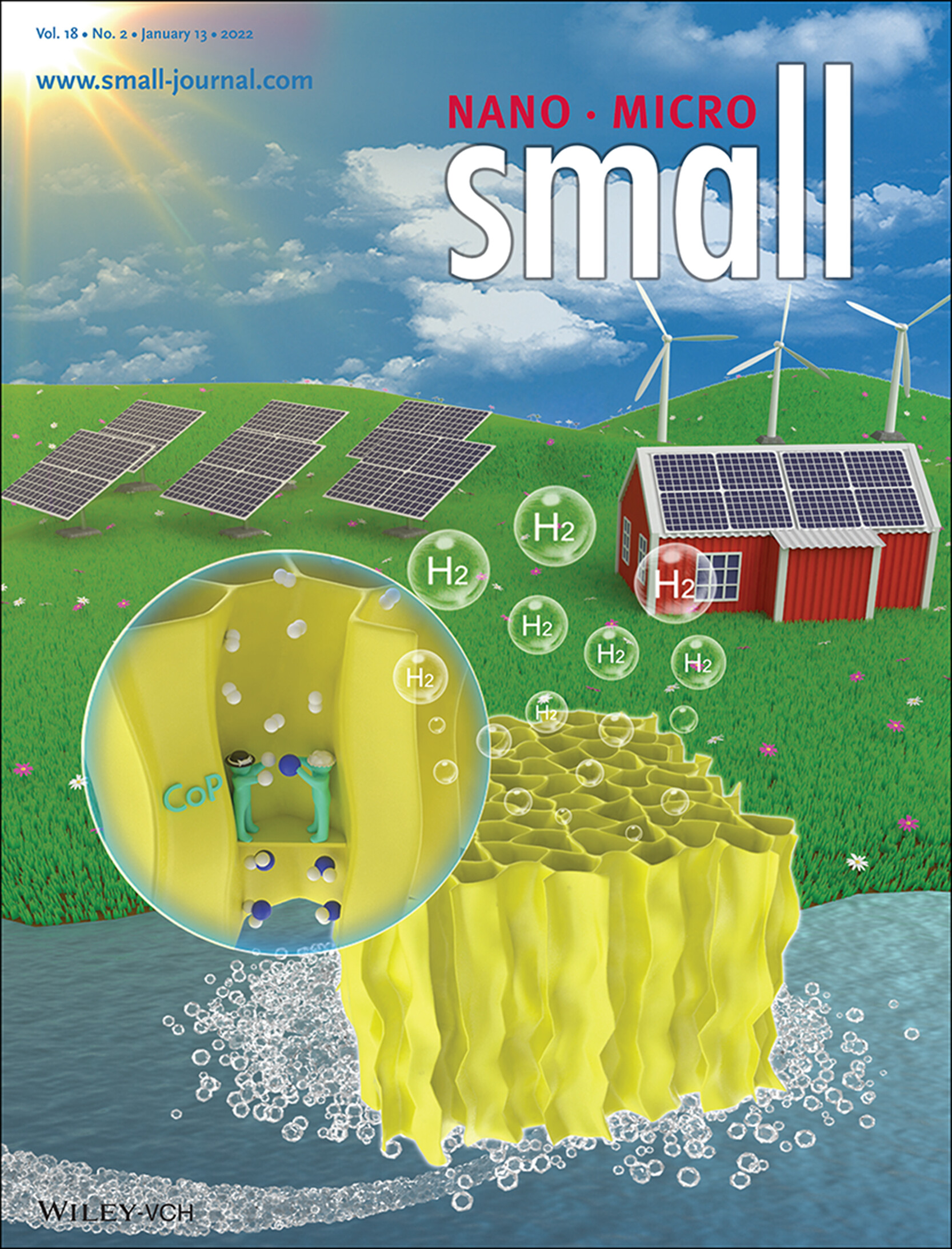
Hydrogen Evolution Reaction
In article number 2103866, Weiyong Yuan, Chang Ming Li, and co-workers report the synthesis of high-density macropores-oriented CoP-impregnated 3-D N-doped carbon-sheets nanostructure via self-assembly, demonstrating superior hydrogen evolution reaction catalytic performance even compared to commercial Pt/C, and thus great potential for industry-scale hydrogen production.
Back Cover
Eliminating Edge Electronic and Phonon States of Phosphorene Nanoribbon by Unique Edge Reconstruction (Small 2/2022)
- First Published: 13 January 2022
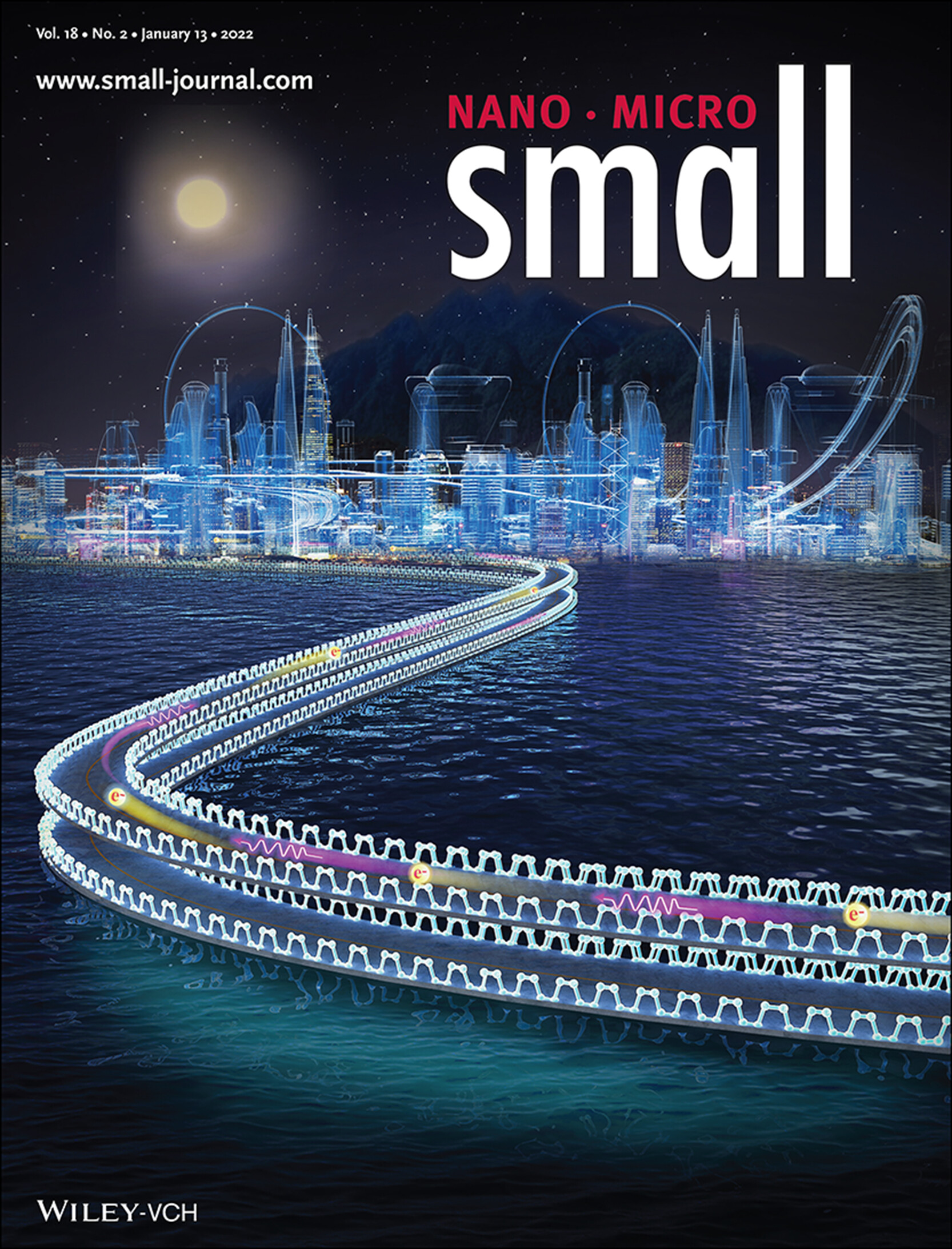
Edge Reconstruction
An unprecedented U-edge reconstruction with the lowest energy is revealed to occur easily in the bilayer phosphorene. Such U-edge reconstruction exhibits unexpectedly ultrafast electronic and thermal transport, nearly without edgeless scattering. More information can be found in article number 2105130 by Junfeng Gao, Gang Zhang, and co-workers.
Masthead
Reviews
Synthesis, Applications, and Prospects of Graphene Quantum Dots: A Comprehensive Review
- First Published: 22 September 2021
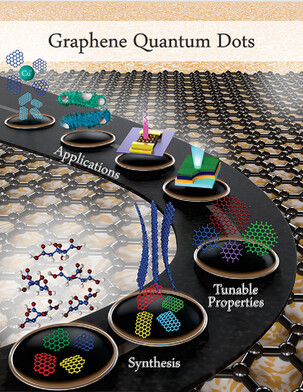
This review provides a comparative and balanced discussion on various perspectives of graphene quantum dots (GQDs). First, the most exciting properties, synthesis and modification strategies, analytical characterizations, and applications of GQDs are presented. Then, the current challenges and future prospects of these emerging carbon-based nanomaterials are highlighted.
Phase-Transfer Exchange Lead Chalcogenide Colloidal Quantum Dots: Ink Preparation, Film Assembly, and Solar Cell Construction
- First Published: 24 September 2021
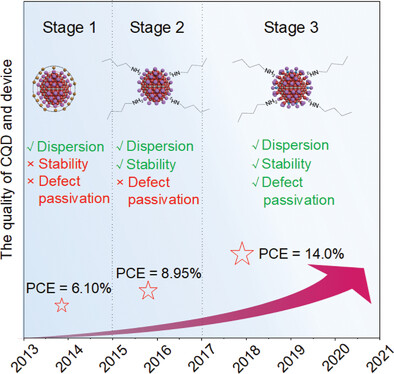
Phase-transfer exchange (PTE) method has been widely employed for colloidal quantum dot (CQD) ink preparation. However, there is no review about PTE method that has been reported until now. In this review, the development of lead chalcogenide CQD ink is summarized, the key factors for high-quality ink preparation are highlighted, and several potential directions for future research are proposed.
Nanoarchitectonics of Metal–Organic Frameworks for Capacitive Deionization via Controlled Pyrolyzed Approaches
- First Published: 28 September 2021
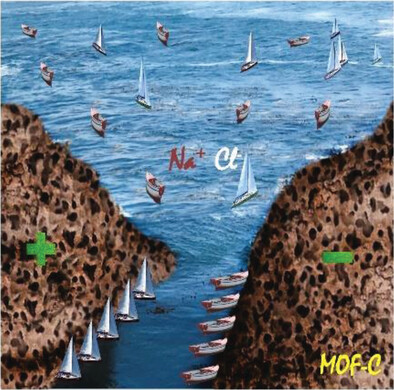
The rational design of precursory metal–organic frameworks (MOFs) is a new approach to improve the non-Faradaic and Faradaic characteristics of electrode materials and increase the energy efficiency and reduce costs of capacitive deionization (CDI). The key compositional and structural considerations for the pyrolyzed MOF approach and their correlations with CDI performance are comprehensively discussed in this article.
Research Articles
Lithium Storage Mechanism and Application of Micron-Sized Lattice-Reversible Binary Intermetallic Compounds as High-Performance Flexible Lithium-Ion Battery Anodes
- First Published: 04 December 2021
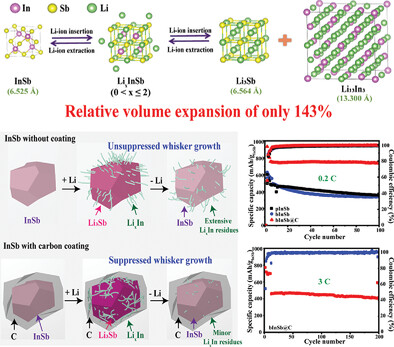
Lattice-reversible binary intermetallic compounds (e.g., indium antimonide (InSb)) are proposed as a promising anode material for high-performance flexible lithium-ion batteries. InSb possesses the advantages of high conductivity and capacity, low volumetric expansion, and lattice-reversibility, and the inherent whisker growth issue can be inhibited by carbon-coating. The micron-sized bInSb@C@CNT electrodes demonstrate outstanding capacity, cycle stability, rate performance, and high flexibility.
Electronic Structure Regulation of Iron Phthalocyanine Induced by Anchoring on Heteroatom-Doping Carbon Sphere for Efficient Oxygen Reduction Reaction and Al–Air Battery
- First Published: 03 December 2021

This paper reports a hybrid electrocatalyst consisting of monolayer FePc and hollow N,S-doped carbon spheres (HNSCs). The charge distribution and d-band center of the Fe atom can be efficiently optimized via the introduction of N,S-doped carbon substrate. Thus, the FePc@HNSC catalyst exhibits outstanding oxygen reduction reaction activity. Moreover, the aluminum–air battery using FePc@HNSC also demonstrates superior battery performance.
Directionally In Situ Self-Assembled, High-Density, Macropore-Oriented, CoP-Impregnated, 3D Hierarchical Porous Carbon Sheet Nanostructure for Superior Electrocatalysis in the Hydrogen Evolution Reaction
- First Published: 05 December 2021
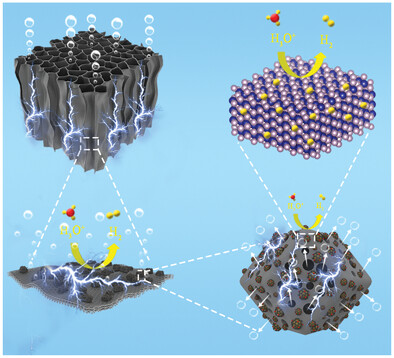
A high-density macropores-oriented CoP-impregnated 3D hierarchical porous N-doped carbon-sheets nanostructure is synthesized via a facile, economical, and universal in situ self-assembly strategy, showing hydrogen evolution reaction catalytic activity superior to those of the most reported non-noble-metal-based catalysts with excellent stability, thus holding great promise for industry-scale hydrogen production from water splitting.
Eliminating Edge Electronic and Phonon States of Phosphorene Nanoribbon by Unique Edge Reconstruction
- First Published: 04 December 2021
Rational Design of Li-Wicking Hosts for Ultrafast Fabrication of Flexible and Stable Lithium Metal Anodes
- First Published: 05 November 2021
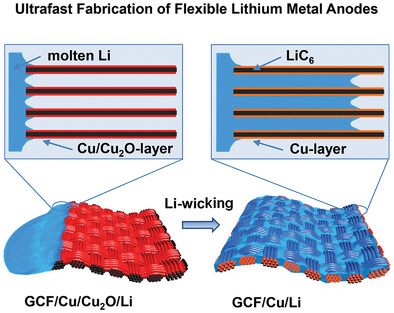
A highly scalable lithium (Li)-wicking strategy is reported for ultrafast fabrication of mechanically flexible and electrochemically stable Li metal anodes. Through the rational design of the interface and structure of the wicking host, the mean speed of Li-wicking reaches 10 m2 min−1, which is 1000 to 100000 fold faster than the reported electrochemical deposition or thermal infusion methods and meets the industrial fabrication speed.
Biomass-Induced Diphasic Carbon Decoration for Carbon Nitride: Band and Electronic Engineering Targeting Efficient N2 Photofixation
- First Published: 18 November 2021
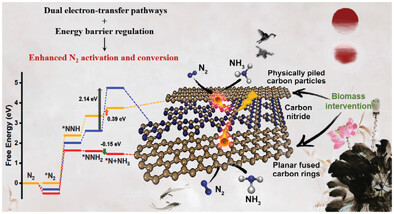
Two carbon textures, in-planar-fused carbon and physically piled carbon, are integrated into carbon nitride via one-pot co-pyrolysis and polymerization of lotus root starch and dicyanamide. The band structure engineering, reaction energy barrier regulation, and dual electron-transfer pathways are synergistically used to boost the photocatalytic nitrogen-fixing performance on the as-developed diphasic carbon-decorated photocatalyst.
Optimizing Microenvironment of Asymmetric N,S-Coordinated Single-Atom Fe via Axial Fifth Coordination toward Efficient Oxygen Electroreduction
- First Published: 20 November 2021
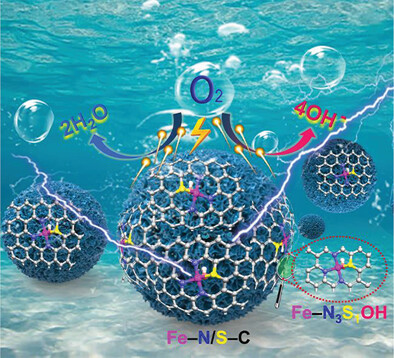
Asymmetric N,S-coordinated single-atom Fe with extra axial fifth OH coordination (Fe−N3S1OH) embedded in N,S codoped porous carbon nanospheres (Fe−N/S−C) are fabricated. Experimental observations and theoretical calculations demonstrate that benefiting from sufficient active sites exposure, fast ions/mass transportation, and optimized Fe 3d orbitals, the as-prepared FeN/SC exhibits superior oxygen reduction reaction performance.
Bandgap Shrinkage and Charge Transfer in 2D Layered SnS2 Doped with V for Photocatalytic Efficiency Improvement
- First Published: 20 November 2021
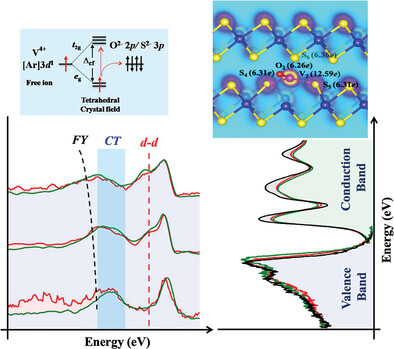
The interstitially tetrahedral O–V–S site in the vdW gap of V-doped 2D SnS2 establishes the origin of the charge transfer mechanism between metal ion V4+ 3d and ligand O2- 2p/S2- 3p states and the decrease in the band gap by studying synchrotron-based techniques and first-principles density functional theory.
Optimized Pt Single Atom Harvesting on TiO2 Nanotubes—Towards a Most Efficient Photocatalyst
- First Published: 06 November 2021
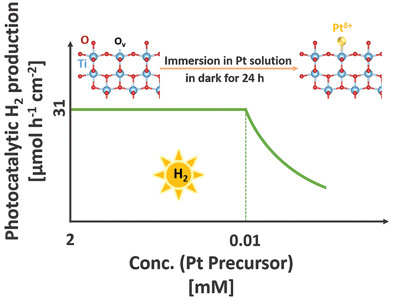
TiO2 nanotubes with surface Ti3+-oxygen vacancy defects are obtained by a suitable annealing treatment. Subsequently, a simple immersion of the tubes in a Pt solution in dark for 24 h leads to surface trapping and stabilizing of Pt single atoms (SAs). Remarkably and most importantly, an optimized SA density and an outstanding photocatalytic H2 evolution performance can be achieved with a Pt precursor solution at a concentration as low as 0.01 mm.
Ultrafast Na Transport into Crystalline Sn via Dislocation-Pipe Diffusion
- First Published: 21 November 2021
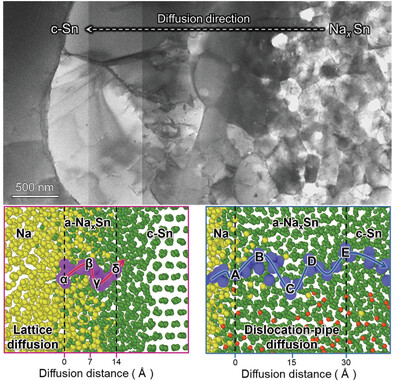
By performing direct-contact sodiation experiments and multiscale simulations that combined classical molecular dynamics and first-principle calculations on the Na-Sn system, it is found that Na diffusion into crystalline Sn induces tensile stresses near the propagating interface, promoting the nucleation of high-density dislocations. These dislocations facilitate the preferential transport of Na and accelerate the diffusion of these ions into crystalline Sn at ultrafast rates via dislocation-pipe diffusion.
Laser-Assisted Fabrication of Injectable Nanofibrous Cell Carriers
- First Published: 21 November 2021
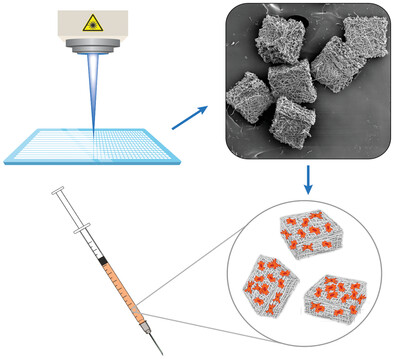
The proposed laser-assisted microscaffold (MSs) fabrication can effectively produce thousands of identical MSs, leading to the development of injectable electrospun nanofibers. The efficient cell attachment on the MSs surface creates agglomerations of cell-populated MSs, while MSs suspended in hyaluronic acid can be efficiently injected through a 26G needle by applying an ejecting force suitable for manual injection.
Spatiotemporal Quantification of Endosomal Acidification on the Viral Journey
- First Published: 16 November 2021
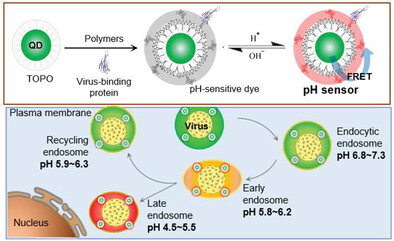
A spatiotemporal imaging method is developed to quantify endosomal acidification of viruses in host cells using a fluorescence resonance energy transfer based ratiometric pH sensor, and it is demonstrated that influenza viruses undergo a two-step endosomal acidification process during their infection.
Octopus-Type Crown-Bisphthalocyaninate Anchor for Bottom-Up Assembly of Supramolecular Bilayers with Expanded Redox-Switching Capability
- First Published: 15 October 2021
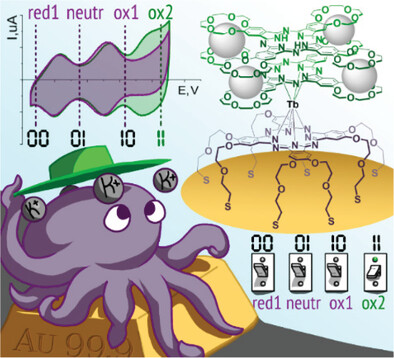
A new heteroleptic bisphthalocyaninate with one ligand bearing eight thioacetate terminated “tentacles” and one tetra-crown substituted ligand is synthesized. Self-assembled monolayer based on this complex is formed on gold. Supramolecular crown-ether–potassium interaction is then used to append tetra-crown-phthalocyanine adlayer that provides another available redox-state in the nanoscale system, totaling four, which can all be read-out optically.
Ultrafast Room-Temperature Synthesis of Self-Supported NiFe-Layered Double Hydroxide as Large-Current–Density Oxygen Evolution Electrocatalyst
- First Published: 12 November 2021
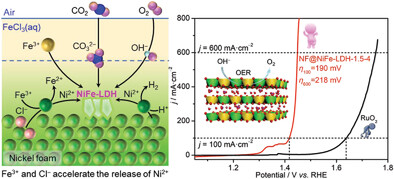
NiFe-layered double hydroxide (LDH) array on NF is formed spontaneously and rapidly under room temperature. Its reasonable formation mechanism is prudently established. NiFe-LDH array on NF has remarkable oxygen evolution reaction activity and stability in alkaline electrolyte. Its water splitting performance well meets the requirements of industrial hydrogen production.
Lithium Storage Performance Boosted via Delocalizing Charge in ZnxCo1−xPS3/CoS2 of 2D/3D Heterostructure
- First Published: 29 October 2021
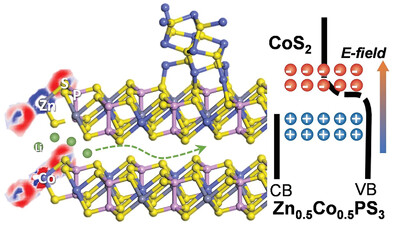
A promising anode material consisting of bimetallic thiophosphate ZnxCo1−xPS3 and CoS2 with 2D/3D heterostructure is prepared. The hetero-Zn alloying can produce an enhanced asymmetric E-field to accelerate electron transfer and adjust the interlayer distance to create small volume changed MPS3 electrodes. Additionally, metallic CoS2 deposited on semiconductor ZnxCo1−xPS3 can form a strong E-field, favoring the transportation of electrons.
A Designed Lithiophilic Carbon Channel on Separator to Regulate Lithium Deposition Behavior
- First Published: 06 November 2021
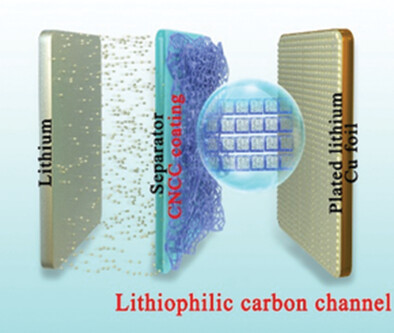
A lithiophilic carbon channel on separator is designed to regulate lithium deposition behavior. As a result, dendrite-free deposition can be achieved and lithium nucleation overpotential can be greatly reduced. High performance of extra-long cycle life over 2600 h in Li|Li cell and average Coulombic efficiency (CE) of 98.5% in Li|Cu cell with modified separator is realized.
Nitrogen-Doped Carbon Networks with Consecutive Conductive Pathways from a Facile Competitive Carbonization-Etching Strategy for High-Performance Energy Storage
- First Published: 22 October 2021

Nitrogen-doped carbon polyhedron@carbon nanosheet (NCP@CNS) hybrids with consecutive conductive networks are synthesized through a competitive carbonization-etching strategy using zeolitic imidazolate framework-8 as both the carbon and nitrogen sources. Benefiting from the well-matched micro/mesoporosity, consecutive electronic networks, and high nitrogen doping, the NCP@CNS hybrids as supercapacitor electrodes possess high specific capacitance, excellent rate performance, and good cycling stability.
Compressible Ionized Natural 3D Interconnected Loofah Membrane for Salinity Gradient Power Generation
- First Published: 07 November 2021
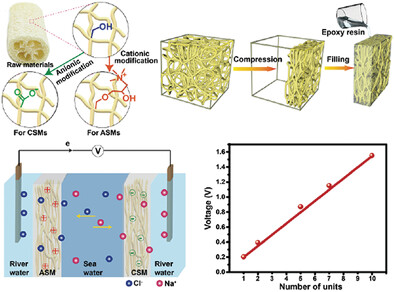
Using nature-derived loofah sponge as the ion conductive scaffold, this work fabricated compressible, ion conductive, and dimensionally stable ion-selective membranes. The reverse electrodialysis employing the modified cation and anion exchange membranes resulted in a maximum power density of 18.3 mW m−2 at the gradient of artificial seawater and river water. When ten units of loofah-based ion-selective membranes are stacked in series, a voltage of 1.55 V is achieved.
Oxygen Vacancy Engineering Synergistic with Surface Hydrophilicity Modification of Hollow Ru Doped CoNi-LDH Nanotube Arrays for Boosting Hydrogen Evolution
- First Published: 05 November 2021
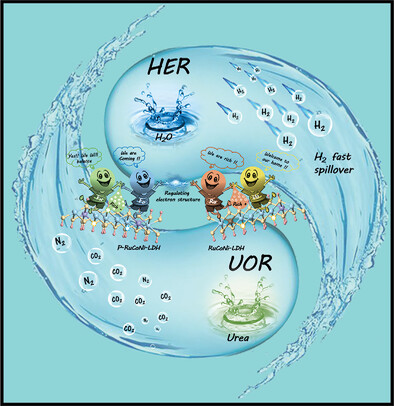
With the Ru-doping in CoNi-LDH, the air-plasma treatment was tend to introduce appropriate O and N filling that can effectively regulate the electronic structure. What's more, the plasma treatment also increases the superwettability of the samples which facilitate the H2 spillover process. The synergistically regulation of the intrinsic electronic structure and interface wettability of CoNi-LDH can boost the HER process.
Silver Peroxide Nanoparticles for Combined Antibacterial Sonodynamic and Photothermal Therapy
- First Published: 05 November 2021
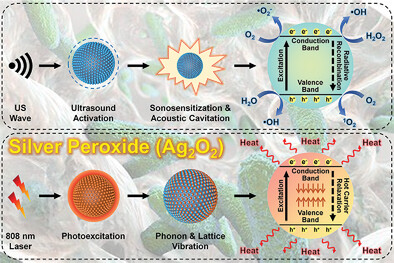
Silver peroxide nanoparticles (Ag2O2 NPs) supply H2O2, O2, and Ag+ ions with excellent photothermal conversion efficiency and ROS production under near-infrared light and ultrasound irradiation. The combined antibacterial sonodynamic and photothermal therapy boosts antibacterial and antibiofilm activity in vitro and in vivo.
Advanced Nanoengineering Approach for Target-Specific, Spatiotemporal, and Ratiometric Delivery of Gemcitabine–Cisplatin Combination for Improved Therapeutic Outcome in Pancreatic Cancer
- First Published: 10 November 2021
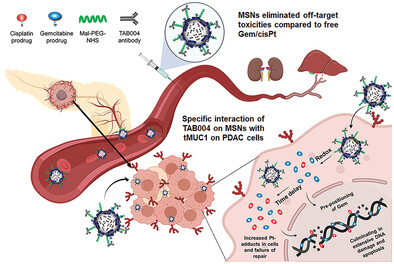
A multifunctional mesoporous silica nanoparticle (MSN)-based platform for the target-specific, spatiotemporal, ratiometric, and safe co-delivery of gemcitabine (Gem) and cisplatin (cisPt) is developed. This platform efficiently suppresses tumor growth and eliminates the off-target toxicities of this highly toxic chemotherapy combination in a syngeneic and clinically relevant genetically engineered pancreatic ductal adenocarcinoma (PDAC) mouse model.
Acidic TME-Responsive Nano-Bi2Se3@MnCaP as a NIR-II-Triggered Free Radical Generator for Hypoxia-Irrelevant Phototherapy with High Specificity and Immunogenicity
- First Published: 11 November 2021
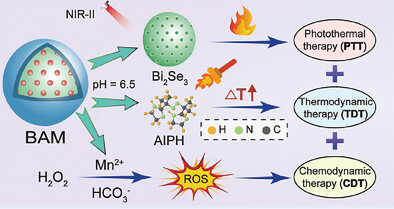
An acidity/near-infrared-II light dual-responsive theranostic platform is established for promoted cooperative CDT/PTT/TDT and immunogenicity elicitation with high tumor specificity. The multifunctional hybrid nanocomplex (Bi2Se3/AIPH@MnCaP) is developed by in situ mineralizing Mn-doped CaP onto the surface of AIPH-encapsulated mesoporous nano-Bi2Se3.
Precisely Defining Local Gradients of Stimuli-Responsive Hydrogels for Complex 2D-to-4D Shape Evolutions
- First Published: 05 November 2021
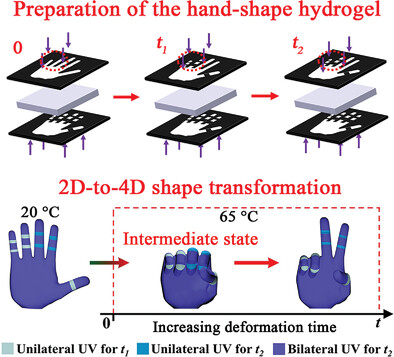
The hydrogels prepared by photopolymerization can get rid of the inseparable monotonic relationship between deformation rate and degree of traditional self-shaping hydrogels to deform in a novel 2D-to-4D mode. Through controlling the UV irradiation direction and time to precisely program the local gradients of self-shaping hydrogels, various unprecedented ultra-complex 2D-to-4D shape transformations can be achieved on demand.
Editor's Choice
Interfacial Assembly of Nanowire Arrays toward Carbonaceous Mesoporous Nanorods and Superstructures
- First Published: 05 November 2021

Biomass-derived anisotropic nanowire-arrays based mesoporous nanorods and teeth-like superstructures are successfully prepared, through a simple and straightforward polyelectrolyte assisted soft-templating HTC approach. A surface energy regulated anisotropic interfacial assembly mechanism induced by the synergetic interactions between micelles, nanorods, and PSSMA is then proposed, in which PSSMA acts as not only stabilizer but also structure-directing agent.
Topographic Cues Guiding Cell Polarization via Distinct Cellular Mechanosensing Pathways
- First Published: 05 November 2021
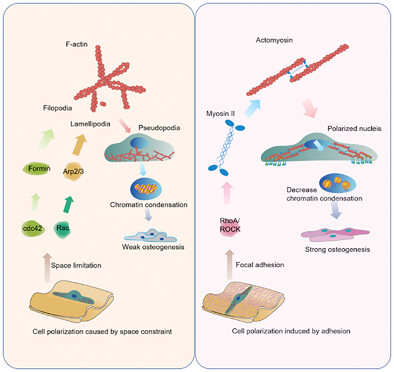
Both space constraint and adhesion induction effects induce similar polarized morphology for the adhesive cells. Here, distinct molecular mechanisms are revealed. The adhesion induction leads to focal adhesion formation and activates the RhoA/ROCK pathway to promote the myosin-based intracellular force. Meanwhile, the space constraint activates the pseudopodia via Rac and CDC42 signaling in an intracellular force-independent manner.
Co-Assembly of Biosynthetic Chiral Nematic Adhesive Materials with Dynamic Polarized Luminescence
- First Published: 12 November 2021
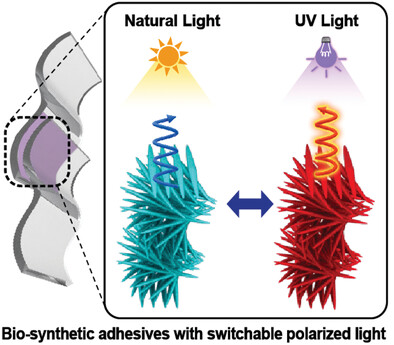
Here, biosynthetic adhesive materials composed of chiral nematic cellulose nanocrystal–polyelectrolyte–rare-earth metal complexes are reported. The adhesives demonstrate synergistically amplified strong and dynamic photoluminescence with highly asymmetric and switchable circular polarization. Additionally, it displays universal high adhesion on both hydrophilic and hydrophobic substrates, which can find its effective application to security optical coding.
Realizing Enhanced Thermoelectric Performance and Hardness in Icosahedral Cu5FeS4−xSex with High-Density Twin Boundaries
- First Published: 05 November 2021
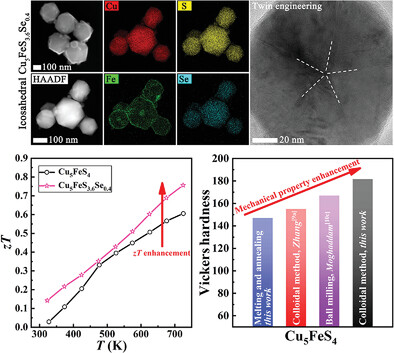
Cu5FeS4−xSex (0 ≤ x ≤ 0.4) icosahedral nanoparticles, containing high-density twin boundaries, have been synthesized by a colloidal method. The peak power factor and zT value of Cu5FeS3.6Se0.4 reach 0.84 mW m−1 K−2 and 0.75 at 726 K, respectively. Our twin boundary-containing Cu5FeS4 also obtains a high Vickers hardness of 182.
Rising Stars
Purcell Enhancement of a Cavity-Coupled Emitter in Hexagonal Boron Nitride
- First Published: 27 November 2021
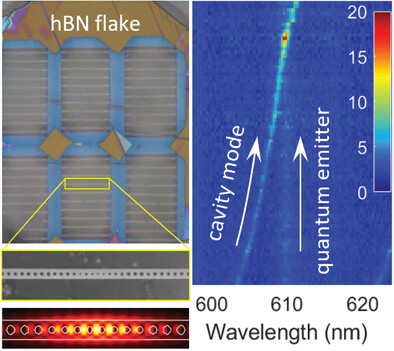
In this work, a monolithically cavity integrated single photon-emitter from hexagonal boron nitride is demonstrated. By gas condensation tuning at cryogenic temperature, the optical resonance of the photonic crystal cavity is tuned and coupled to the emission wavelength, which enables the study of the Purcell enhanced single-photon emitter.
Millefeuille-Inspired Thermal Interface Materials based on Double Self-Assembly Technique for Efficient Microelectronic Cooling and Electromagnetic Interference Shielding
- First Published: 28 November 2021
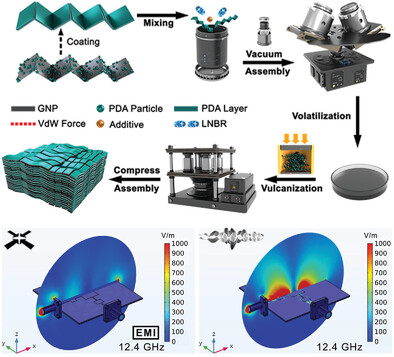
Herein, a multifunctional thermal interface material is fabricated through the double self-assembly technique to fulfil advanced thermal management applications concerning electromagnetic interference (EMI). According to the building of oriented multilayered microstructure and interfacial enhancement via nano-coating, the composite maintains optimized coordination of the EMI shielding (shielding efficiency over 99.9999%) and thermal conductivity (in-plane TC of 233.67 W m−1 K−1).
Multi-Scale Nanoarchitectured Fibrous Networks for High-Performance, Self-Sterilization, and Recyclable Face Masks
- First Published: 30 November 2021
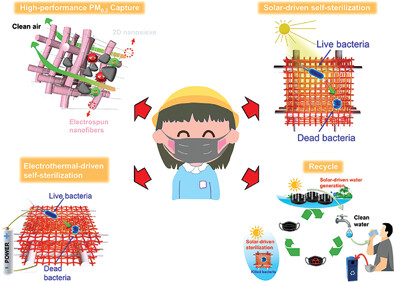
Face masks based on multi-scale nanoarchitectured nanofiber/carbon nanotube fibrous networks are developed with excellent comprehensive performance including excellent filtration performance for PM0.3 (>99.994% PM0.3 removal and <0.05% atmosphere pressure), charming capacity of self-sterilization (>99.986% in 5 min under 1 sun and >99.9999% in 2 min in sunless scenes), and recyclability for the protection of public health and the environment.
Protrudent Iron Single-Atom Accelerated Interfacial Piezoelectric Polarization for Self-Powered Water Motion Triggered Fenton-Like Reaction
- First Published: 27 November 2021
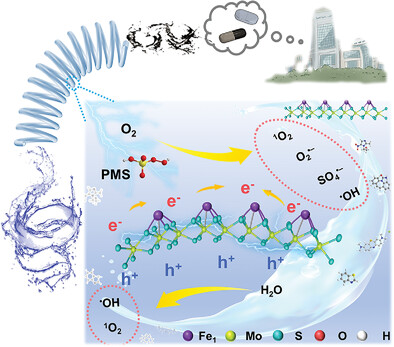
Harvesting water motions energy to trigger piezo-activation of peroxymonosulfate by protrudent Fe atomic sites immobilized on MoS2 for wastewater treatment is reported under natural water fluid. The investigation provides a pathway for single atomic-mediated self-powered piezo-activation of Fenton-like reactions by harnessing ambient energy from the water flow of simulated water drainage to purify wastewater.
Bioorthogonal Disassembly of Tetrazine Bearing Supramolecular Assemblies Inside Living Cells
- First Published: 29 November 2021

Besides the bioorthogonal labeling and prodrugs activation, the reaction between tetrazine and trans-cyclooctene can disrupt π–π stacking and induce the disassembly of a series of enzyme-instructed supramolecular assemblies in vitro and inside living cells. Such a bioorthogonal disassembly strategy actively removes assemblies in the biological milieu to alleviate nano-toxicities, which may be applicable for treating aberrant protein assemblies.




